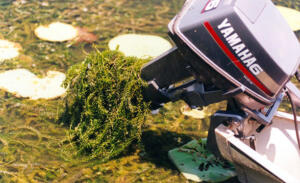Imagine the most beautiful summer day: The sun is shining, the fish are biting and a cool breeze is blowing in. You enter a promising cove and notice patches of bright green vegetation floating on the water.
After a few casts, you feel weight on your line. You eagerly reel in your catch only to find a string of those bright green weeds dangling from your hook.
Moments later, they’re wrapped around your propeller.

These pesky plants, known as hydrilla, aren’t just annoying water vegetation. They are one of the worst invasive aquatic species in the United States.
Such species, and others like it, pose serious threats to freshwater ecosystems, human safety and the economy.
As a lake lover, it is important that you familiarize yourself with these “aquatic hitchhikers” and learn how you can prevent an infestation on your favorite body of water.
Common Species
Hydrilla – These plants are characterized by bright green, often serrated, leaves on tubular stems that extend into the water as deep as 30 feet.
Tendrils of leaves often grow together, forming patches across the water’s surface. These patches prevent sunlight from reaching underwater vegetation and restrict water flow.
Patches of hydrilla also serve as perfect breeding grounds for mosquitoes.
Water Hyacinth – This species is known for its thick, waxy, oval-shaped leaves and lavender flowers that sit atop spongy, air-filled stems.
These plants are notorious for rapid growth: a single population can double in size in just one week.
Water hyacinth’s ability to multiply quickly, combined with its seed-viability of up to 30 years, makes the species extremely dangerous to the surrounding environment.
Populations of hyacinth are often large, and as the vegetation dies off and starts to decay, the amount of oxygen in the water is reduced. This reduction ultimately ends up suffocating the fish who live there.
The larger the population, the quicker the lake’s water is de-oxygenated.
Zebra Mussels – These animals are identified by their “D”-shaped, creamy shells and their brown/black zig-zag stripes.
Zebra mussels are one of the most devastating species to be introduced to America’s fresh water bodies as population densities can reach more than 100,000 zebra mussels per square meter.
A single female zebra mussel is capable of producing as many as one million eggs in a summer, each of which has an average lifespan of two to five years after fertilization.
This species costs communities thousands of dollars in maintenance each year. Dense mussel populations clog intake pipes and filters and affect effectiveness of water treatment plants.
Zebra mussels also pose a threat to human safety with their sharp, broken shells blanketing beaches and lake beds.
Prevention Methods
Though many lakes are already infected by these and other common invasive species, there are still plenty of bodies of water left to protect.
Whether your lake is free of such species or already home to one of these aquatic hitchhikers, it is important that you take the necessary precautions to avoid introducing new species to its waters.
There are a multitude of ways to ensure such species are not introduced in your lake.
Stopaquatichitchhikers.org, a site dedicated to keeping the country’s freshwater bodies safe, is currently promoting a “Clean. Drain. Dry.” campaign, which emphasizes that prevention starts with you.
The website encourages lake goers to remove all mud, vegetation and visible organisms from lake equipment upon leaving the water and before transporting this equipment back home.
Equipment exteriors should be rinsed with hot, high-pressurized water and interiors with warm, low-pressurized water. Boat and jet ski motors should also be flushed with hot water for at least two minutes after exiting the water.
Before leaving the boat ramp or water access area, all devices that may retain water, including the bilge and livewells, should be drained.
All equipment should be dried off with a towel and allowed to dry out for at least five days before reuse.
Though these steps may seem optional or unnecessary, each is vital to keeping your lake protected from potentially harmful invasive species.
For more information on the hitchhikers in your area, and additional prevention tactics, visit the the Stop Aquatic Hitchhikers website.

